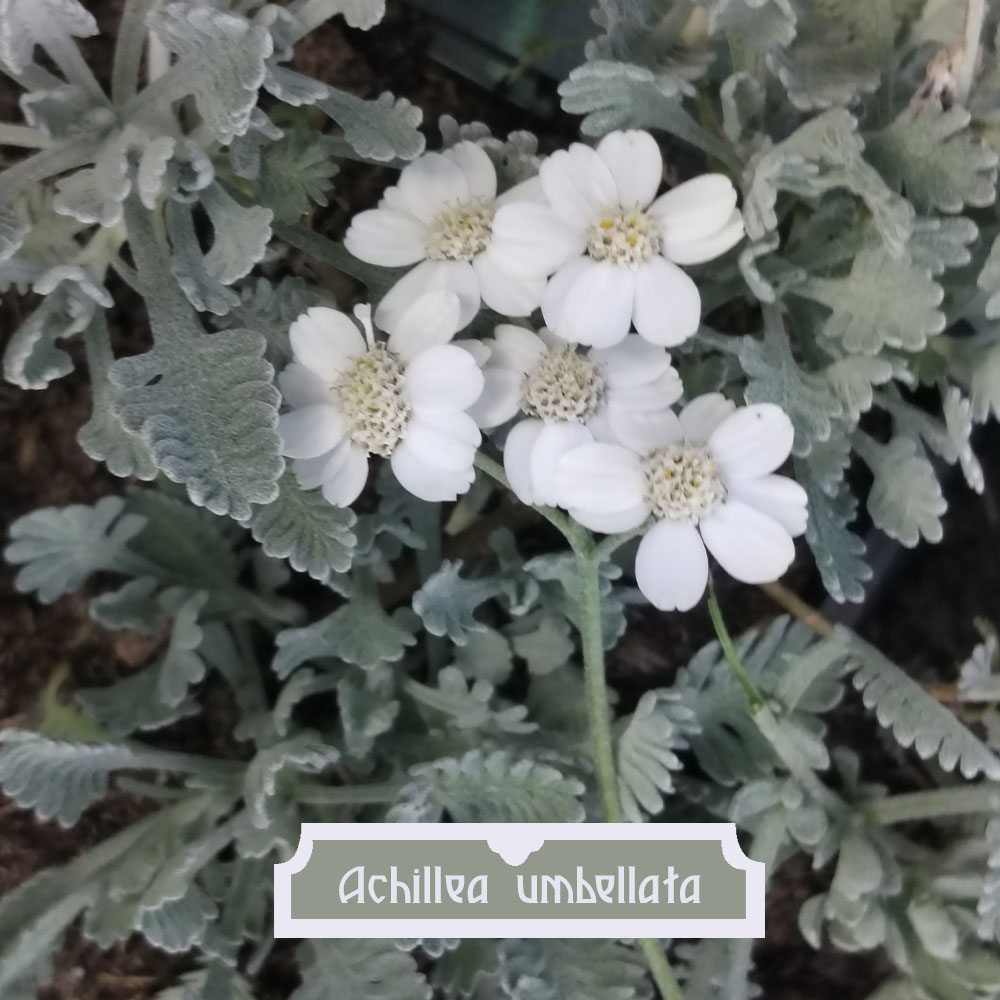No products in the cart.
Achillea umbellata
Couvre-sol gris doux avec de petites fleurs blanches.
Note 0 sur 5
0 avis clients
6,00 € – 14,00 €Plage de prix : 6,00 € à 14,00 €
Tags: chaud, graphique, vivace, plant, plant en pot, secheresse, soleil, vivace, vivace en pot, le xeriscaping (aménagement paysager économe en eau).
SKU: pda700
Catégorie: Bien au Balcon, Bouquet, Plantes Pérsistantes, Résistantes au Gel, Les Dames Grises, Couvre-Sol, Réensauvagement

Achillea umbellata
6,00 € – 14,00 €Plage de prix : 6,00 € à 14,00 €
Achillea umbellata est une petite vivace duveteuse qui pousse près du sol, formant de coussins argentés de feuilles finement découpées – aussi agréables à regarder qu’au toucher.
Son feuillage finement denté et duveteux, d’un gris argenté éclatant en hiver, devient presque blanc en été sous l’effet de la chaleur et de la sécheresse. Il rappelle à bien des égards Tanacetum densum subsp. amani.
Les fleurs sont des ombelles plates d’un blanc pur – la forme typique des fleurs d’achillée – apparaissant au printemps, entre avril et juin.
Le feuillage est persistant, apportant également de l’intérêt en hiver.
Achillea umbellata forms a valuable-looking ground cover, 15–25 cm tall in flower and 10–15 cm for the foliage, depending on growing conditions.
Toutes les achillées aiment le soleil et sont très rustiques.
Non envahissante, résistante, peu exigeante en sol et économe en eau, cette achillée est idéale pour les pentes sèches et arides. Elle contribue aussi à limiter les mauvaises herbes tout en ajoutant une touche raffinée au jardin.
👨🌾CONSEILS DE JARDINAGE👨🌾:
-
- ☀️ Préfère le plein soleil et un sol sec, bien drainé.
- 💧 Appliquer du paillis autour de la touffe aidera à retenir l'humidité plus longtemps.
- ✂️ Tailler les tiges à 20 cm du sol en janvier favorise une bonne reconstitution.
- ➗ Divisez les touffes lorsqu'elles commencent à se multiplier. Ce n'est pas invasif, mais peut être un croissant vigoureux.
Discover how to garden with Achillea umbellata:
-
- Inspiration: Jardin Sec: Mediterranean Style Gardening
- Coussins : à associer avec des plantes en coussin comme Geranium sanguineum, Erigeron karvinskianus, Nepeta x faassenii ou d’autres achillées (millefolium, coarctata, nobilis, etc.). Geranium sanguineum, Erigeron karvinskianus, Nepeta x faassenii or other yarrows (Achillea millefolium).
- Ground covers: Combine with mat-forming perennials such as various Thymus species, Origanum ou Rosmarinus prostratus
The Tales & The Botany: Achillea umbellata
Like its relatives in the Achillea genus, Achillea umbellata has been celebrated for centuries for its herbal properties, though in the garden it’s mostly prized for its airy white flowers, delicate foliage, and pollinator-friendly charm.
Cette excellente vivace de rocaille demande peu de désherbage grâce à ses propriétés allélopathiques*.
L’allélopathie, comme nous le rappellent nos amis les Thymus, est la capacité de certaines plantes à synthétiser des composés au niveau de leurs racines qui inhibent la germination et la croissance des autres graines – assurant ainsi la domination complète d’une espèce une fois qu’elle est suffisamment développée.
Le nom du genre Achillea pays homage to the legendary Greek hero Achilles, who, according to folklore, used plants of this genus to treat soldiers’ wounds.
The species epithet umbellata refers to the characteristic flat-topped, umbrella-like clusters of tiny flowers that appear in late spring, giving the plant its airy, textured appeal.
🌸 Morphologie Florale
The flowers of Achillea umbellata form ombelles plates,, creating a delicate cloud of white at the top of short, erect stems.
Chaque petite fleur est actinomorphe, with five fused petals, and collectively they attract a wide range of pollinators, from bees and hoverflies to small butterflies.
Les feuilles, alternate, finely dissected, and feathery, giving a soft, lacy texture that contrasts beautifully with coarser-leaved companions.
Au toucher, le feuillage dégage un slight herbal aroma, hinting at its traditional medicinal uses and adding sensory interest to the garden.
🌱 Biologie Reproductive
Achillea umbellata is hermaphrodite, capable of self-pollination but thriving with cross-pollination by insects.
Les fruits sont des small, dry achenes, which can self-seed under ideal conditions, helping the plant naturalize in sunny, well-drained areas.
La floraison s’étend de la fin du printemps au début de l’été,et le rabattage des fleurs fanées peut prolonger légèrement la floraison.
The airy floral structure and aromatic foliage make it particularly attractive to pollinisateurs,, supporting garden biodiversity while providing a delicate visual display.
🌍 Écologie & Adaptations
Achillea umbellata thrives in temperate and Mediterranean-style gardens, particularly in:
-
- Rockeries and alpine gardens: Forms compact mats that stabilize soil on slopes and create airy, delicate white floral displays.
- Pollinator-friendly borders: Flowers provide nectar for bees, butterflies, and hoverflies, supporting garden biodiversity.
- Sun-exposed sites: Full sun encourages prolific flowering and keeps foliage compact, while the plant tolerates poor, well-drained soils.
Principales adaptations :
-
-
💦 Une fois établies, elles tolèrent une certaine sécheresse Finely divided, feathery leaves minimize water loss and help the plant survive dry periods.
-
Amatrice de soleil : Performs best in full sun, though light shade is tolerated.
-
Facile d’entretien : Resilient foliage and compact habit require minimal care.
-
Longue période de floraison : Umbels bloom from late spring into early summer, providing continuous nectar and visual interest.
-
Self-supporting, mat-forming habit: Ideal for front-of-border planting, rockeries, or container use.
-
Fun fact: Like other members of the Achillea genus, Achillea umbellata has a long history of medicinal use, but in modern gardens it is mostly celebrated for its airy white flowers, lacy foliage, and pollinator-friendly charm.
Autres Noms:
Umbellate Yarrow
🌍 Origine
Grèce
| Poids | 0,5 kg |
|---|---|
| Taille du Pot | 9×9 cm, 2L |
| Couleur des Fleurs | Blanche |
| Floraison | Avril, Mai, Juin |
| Sol | Sec, Bien Drainant |
| Exposition | ☀️ Plein soleil |
| Rusticité | -15°C to -20°C |
| Taille | 0.3m H x 0.5m L |
Commentaires
0
Note 0 sur 5
0 avis clients
5
0
4
0
3
0
2
0
1
0
Seuls les utilisateurs connectés les clients qui ont acheté ce produit peuvent laisser un avis.
Vous pourriez également aimer…
Thymus longicaulis ‘Odoratus’
Un couvre-sol à croissance rapide, avec des feuilles fortement aromatiques et des fleurs rose vif en début d'été.
Un couvre-sol à croissance rapide, avec des feuilles fortement aromatiques et des fleurs rose vif en début d'été.
Note 0 sur 5
Thymus ‘Duftkissen’
Une variété de thym intensément parfumée et abondamment fleurie, avec des feuilles douces gris-vert.
Une variété de thym intensément parfumée et abondamment fleurie, avec des feuilles douces gris-vert.
Note 0 sur 5
Achillea ptarmica Boule de Neige
White pompom flowers to attract bees to your garden all summer long.
White pompom flowers to attract bees to your garden all summer long.
Note 0 sur 5
Nepeta x faassenii Six Hill’s Giant
Variété plus grande aux feuillage plus résilient
Variété plus grande aux feuillage plus résilient
Note 0 sur 5
Autres Produits
Cerastium tomentosum var. columnae
Un couvre-sol étalé gris-vert des montagnes.
Un couvre-sol étalé gris-vert des montagnes.
Note 0 sur 5
Artemisia Valerie Finnis
Une variation de l'Artemisia semi-persistante et aromatique
Une variation de l'Artemisia semi-persistante et aromatique
Note 0 sur 5
Euphorbia myrsinites
Connue pour sa forme retombante de feuillage gris argenté et ses fleurs éclatantes.
Connue pour sa forme retombante de feuillage gris argenté et ses fleurs éclatantes.
Note 0 sur 5
Kalanchoe daigremontiana
Une succulente dentelée originaire de Madagascar, connue sous le nom de Mère de Mille.
Une succulente dentelée originaire de Madagascar, connue sous le nom de Mère de Mille.
Note 0 sur 5
Tradescantia Blushing Bride
Magnifiques touches de rose et de blanc qui apparaissent lors des nuits les plus froides
Magnifiques touches de rose et de blanc qui apparaissent lors des nuits les plus froides
Note 0 sur 5
Melissa officinalis
Une aromatique adorée par les abeilles, les familles royales et les amateurs de thé.
Une aromatique adorée par les abeilles, les familles royales et les amateurs de thé.
Note 0 sur 5
Hieracium maculatum Leopard
Une plante vivace originaire avec des feuilles bleu-vert et une grande fleur jaune.
Une plante vivace originaire avec des feuilles bleu-vert et une grande fleur jaune.
Note 0 sur 5
Hellebore argutifolius
Plante vivace à fleurs d'hiver avec des feuilles bleu-vert marbrées.
Plante vivace à fleurs d'hiver avec des feuilles bleu-vert marbrées.
Note 0 sur 5
Delosperma cooperi
Une vivace naine connue pour ses fleurs de couleur vermillon.
Une vivace naine connue pour ses fleurs de couleur vermillon.
Note 0 sur 5
Erigeron kavinskianus
Un tapis de fleurs en forme de marguerites.
Un tapis de fleurs en forme de marguerites.
Note 0 sur 5
Mentha x piperita ‘Chartreuse’
Un menthe épicée, connue pour son utilisation dans la production de liqueurs et de tisanes.
Un menthe épicée, connue pour son utilisation dans la production de liqueurs et de tisanes.
Note 0 sur 5
Stachys byzantina
Feuilles soyeuses blanc-gris et grandes fleurs saisissantes.
Feuilles soyeuses blanc-gris et grandes fleurs saisissantes.
Note 0 sur 5
Glechoma hederacea
Un couvre-sol au parfum doux, produisant de petites fleurs bleues tout au long de l'été.
Un couvre-sol au parfum doux, produisant de petites fleurs bleues tout au long de l'été.
Note 0 sur 5
Vinca minor
Looping elegance and ability to form a low flowering ground cover
Looping elegance and ability to form a low flowering ground cover
Note 0 sur 5
Tanacetum densum subsp amani
Un petit arbuste composé de feuilles douces et finement divisées de couleur gris argenté-blanc.
Un petit arbuste composé de feuilles douces et finement divisées de couleur gris argenté-blanc.
Note 0 sur 5
Echinacea purpurea
Une vivace aux fleurs violettes tout au long de l'été.
Une vivace aux fleurs violettes tout au long de l'été.
Note 0 sur 5
Euphorbia cyparissias Clarice Howard
Une Euphorbia qui ressemble à un doux petit cyprès
Une Euphorbia qui ressemble à un doux petit cyprès
Note 0 sur 5
Vu récemment
Valeriana officinalis
Une vivace qui produit des fleurs roses ou blanches au parfum doux tout au long de l'été.
Une vivace qui produit des fleurs roses ou blanches au parfum doux tout au long de l'été.
Note 0 sur 5
Festuca glauca
Une herbe ornementale bleu métallique.
Une herbe ornementale bleu métallique.
Note 0 sur 5
Carex pendula
A perennial grass ideal for humid banks and shady areas.
A perennial grass ideal for humid banks and shady areas.
Note 0 sur 5
Sedum morganianum ‘Burrito’
A lovely succulent that develops thick trailing stems covered with overlapping, plump, blue-green leaves as it grows.
A lovely succulent that develops thick trailing stems covered with overlapping, plump, blue-green leaves as it grows.
Note 0 sur 5
Artemisia abrotanum
Un buisson gris-vert très parfumé, médicinal et frappant.
Un buisson gris-vert très parfumé, médicinal et frappant.
Note 0 sur 5






















































Il n'y a pas encore de reviews.